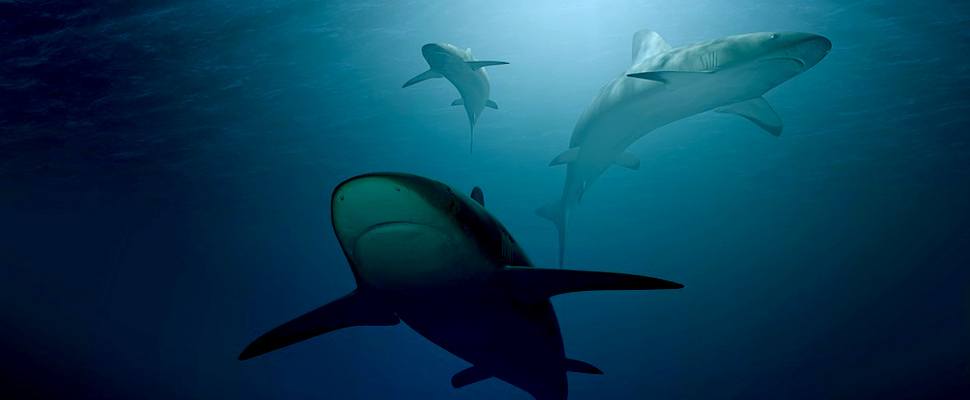Most recent trends in global shark attacks
Attacks in Hawaii are mainly from tiger sharks, Southern Australian attacks are mainly from white sharks, and the eastern US/Gulf of Mexico are a mix of bull sharks (which dominate fatalities) and blacktip and spinner sharks (in non-fatal attacks)

Three sharks in the ocean/ Reference image/ Pexels
Latin American Post Staff
Listen to this article
Shark attacks are a global phenomenon that attracts widespread attention and publicity, often with negative outcomes for shark populations. Despite the widespread perceptions of shark attacks, trends in human water activities and shark populations are both dynamic, resulting in variable rates of shark attacks over space and time. Understanding variable trends in shark attacks may contribute to a better understanding of risk, and a more tempered response in the wake of an attack.
Leer en español: Tendencias más recientes en ataques de tiburones en el mundo
Sharks are of high interest to humans because they are one of a few groups of animals that harmfully interact with humans on a regular, yet uncommon, “shark attack.” Although most of these interactions result in minor injuries akin to that of a dog bite, about six of the 75–100 unprovoked attacks that currently occur worldwide each year result in human mortality. Unprovoked attacks are defined as a bite or near bite of a person (or the board on which he/she is perched) in the shark’s natural environment in the absence of any human provocation.
Despite its relative rarity, shark attack is a cultural phenomenon that draws intense public interest in the popular media with myths and misconceptions routinely perpetuated on film, television, in magazines and newspapers, and in social media.
Three shark species that attract much of that attention are the bull shark (Carcharhinus leucas), tiger shark (Galeocerdo cuvier), and white shark (Carcharodon carcharias). These species are of interest to biologists because they are large, migratory species of cosmopolitan distribution. However, they are also widely-known species in the public sphere owing to their depiction in movies, charismatic megafauna status, and for their association with reports of fatal shark attacks. The increase in attention has hurt these predators. The IUCN (International Union for Conservation of Nature) has classified white sharks as “vulnerable” and bull and tiger sharks as “near threatened”.
According to the International Shark Attack File (ISAF), unprovoked attacks have been increasing in raw numbers for more than a century and in increasingly diverse places. The increase in attacks—particularly in the United States, Australia, and South Africa—have been attributed to increases in human population and the subsequent increase in water-based recreational activities. In fact, although the claim of increasing shark attacks is often made in popular media, when adjusting for population growth the true risk may actually be declining in some places.
Given the confusion surrounding the interpretation of risk of shark interactions coupled with the need for an informed public in places where shark populations are threatened, a group of researchers recently quantified annual probability of shark attacks at the country and regional level and describe location changes in fatal attack and the relative risk of different water-based activities to shark attack. The work was completed by Stephen R. Midway (Louisiana State University), Tyler Wagner (Pennsylvania State University) and George H. Burgess (University of Florida) and published in PloS one.
Also read: The wildcat goldminers doomed by their toxic trade
In general, researchers found that countries with low populations were found to have the highest rates of attack, while countries with high populations (U.S.A., Australia, South Africa) tended to have overall low attack rates. For example, countries like the Bahamas and New Caledonia had high attack rates (>5 shark attacks per million people). Other countries like the USA and Australia had low attack rates (<1 shark attack per million people) but reported higher numbers of attacks.
The study also showed that the majority of countries saw no perceptible trend or change in attack rates over decades, while some of the higher population countries like USA and Australia exhibited increasing attack rates over time.
“The eastern U.S./Gulf of Mexico, Hawaii, and Southern Australia show noticeable increases in attack rates over time, but also with much of the increase occurring since the 1990s. Interestingly, these three regions are dominated by a different shark species. Attacks in Hawaii are mainly from tiger sharks, Southern Australian attacks are mainly from white sharks, and the eastern US/Gulf of Mexico are a mix of bull sharks (which dominate fatalities) and blacktip and spinner sharks (in non-fatal attacks)”, the researchers stated.
The study also examined patterns of shark attack by victim activity over time. The four most common types of activities are diving, surface activity, surfing, and swimming. Surfing and swimming dominated the activities undertaken immediately prior to a shark attack, with diving representing about 10% of the activities.
The researchers concluded that “despite the cultural perception of shark attack risk, the risk at larger scales is not very high, and where it is increasing the rates are low and preventative measures are more likely to take place. However, in highly populated regions— like the Eastern USA and Southern Australia—shark attack rates have doubled in the last 20 years, and while the rates remain relatively low, they should continue to be monitored”.





